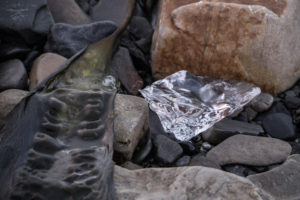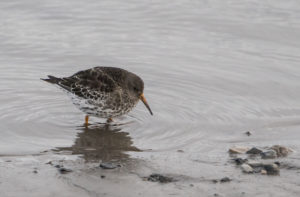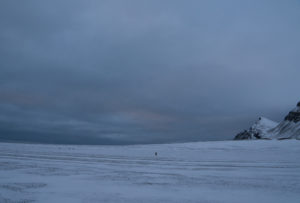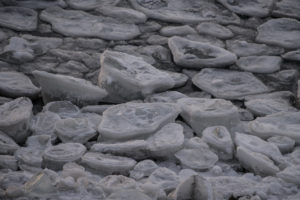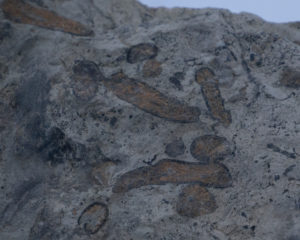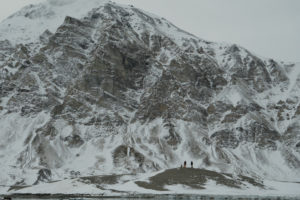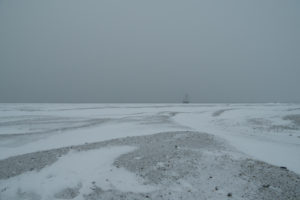by aramatzne@gmail.com | 28 Jan 2019 | Musing
Death
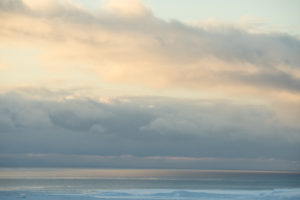
Ice, snow, water, cloud, light, texture
I know that there are no words to make death better and so, I often remain silent for too long when people I know suffer a loss. For all the power of words, they are only words, and they cannot replace the love of a lifetime, a father, husband, or child. They cannot replace the smile, the joy, the humor of one who is no longer.
Process
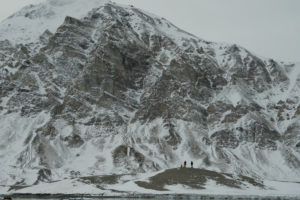
Lessons in scale.
For months I have been ruminating, exploring my experience on Svalbard. I am leery of processing my photos – they cannot truly represent the exquisite colors and textures of the ice, the ocean, the landscape. They cannot convey the quality of light, the weight of the cold air, or smell of snow. They only pluck at the edges of the vast expanse, the scale of mountains, glaciers, open water, and solitude. It does not seem possible to feel the distance, the isolation, or the fortitude of the place, resolutely anchored in the north with nothing but open water and ice between it and the North Pole.
No words
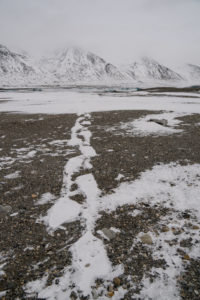
Polar bear tracks disappearing
Now, more than ever in our species’ memories, the Arctic is commonly open water. The ice ages and Little Ice Age are gone. The pack ice of the Arctic Ocean basin, oscillating around the northern axis; building and retreating; seizing ships and men of old; providing a hunting and birthing platform for animals supremely adapted to the cold, the ice, and the dark; releasing accumulated nutrients into the water for the ocean-bound and the flying, diving creatures of summer; this great pack ice is leaving us.
There are no words that can mollify this loss. And yet, now more than ever is no time to be silent.
by aramatzne@gmail.com | 5 Nov 2018 | Musing
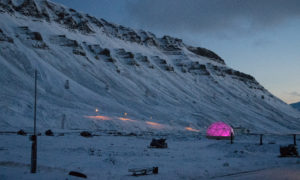
Polar Permaculture dome glows with pink grow lights in Longyearbyen’s early morning light.
“A Yup’ik hunter on Saint Lawrence Island once told me that what traditional Eskimos fear most about us is the extent of our power to alter the land, the scale of that power, and the fact that we can easily effect some of these changes electronically, from a distant city. Eskimos, who sometimes see themselves as still not quite separate from the animal world, regard us as a kind of people whose separation may have become too complete. They call us, with a mixture of incredulity and apprehension, “the people who change nature.”
Barry Lopez in Arctic Dreams
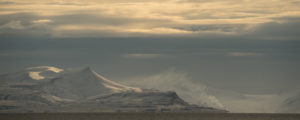
The plume of smoke released from its coal-powered plant exposes Barentsburg’s location from across Isfjorden.
by aramatzne@gmail.com | 3 Sep 2018 | Musing
Then
Cooper Island seems a lifetime ago, the light, the endless bird calls, the sand, the cold and eternal, infernal wind. They are far away now. I returned to Cooper the following summer for a shorter stay, and after demanding a wall tent in which I could stand up and be out of the wind simultaneously. By then George met Darcy Frey and the momentum of Cooper drastically increased as Darcy visited the island, interviewing George and me; later Joe McNally came to photograph Cooper and its residents, avian and otherwise. The story was published in the New York Times Sunday Magazine, George Divoky’s Planet, in 2002. Climate change was under debate (yes, even then and even still) and George’s 30-year data set was a prime source of intrigue. The birds George studied definitively returned to their mutual island almost two weeks earlier than when he began summering, and I use the term loosely, on Cooper Island.
Black Guillemots are cavity nesters; when the winter’s snow and ice retreat sufficiently to allow birds to enter their cavities, make it cozy, and spend time, well, nesting, they return. First, there are some flybys, birds stay in the air, doing visual reconnaissance; how much snow is there on their chosen sand spit? Are the nest sites visible? Flybys become fleeting landings, a strut or two along the ground or a momentary claiming of the nest box, snow preventing entering but exposure allowing dibs, if you will. Finally, birds arrive in droves, the mating rituals begin, and the birds settle into family life, breeding, eggs, chicks, frenetic but fleeting teenage days, and fledging. All racing against the spin of the Arctic seasons that until recently favored the dark, cold months.
As the climate continues to change and shift in ways we mere mortals can only guess, the birds long ago began to play the odds, returning earlier with the expectation that their summer homes will be open and inviting earlier this year than last. And, of course, we, mere mortals, are responsible for the Guillemots’ extended summering. Argue what you like, the world is changing and the creatures we so readily dismiss as animals are way ahead of us in understanding and appreciating the implications. They may not discuss it in political terms or devise computer models to help predict their future, but they recognize the current, if limited, advantage or disadvantage that it presents.
As Guillemots nest earlier each decade, polar bears are forced off the ice as it disintegrates beneath them. Traditionally following the ice north through summer, bears are left swimming farther than possible or are forced to be land-bound through summer. Their lives are made by the heavy winter cold and the extensive pack ice on which they travel and hunt. The small gain for guillemots is an enormous loss for polar bears. And, yes, polar bears are a more charismatic species receiving more attention, but, of course, the world is a poorer place for the loss of any species.
While being able to nest a few weeks early appears beneficial on the surface, the reality is Guillemots feed along the ice pack edge. As eggs are laid, and chicks develop, overworked Guillemot parents repeatedly fly to the pack ice to feed themselves and return to Cooper with one fish at a time for their growing young. When the pack ice is near, this equals fat and happy chicks with plenty of Arctic cod to help them grow toward fledging. As the pack recedes from shore and the distance increases, chicks feed less often; parents burn more of their strength commuting and are sometimes required to shift to less desirable forage fish. The location of the ice can change many times through a season; but as the overall size of the pack decreases, the time it is within range of the breeding colony can also decrease.
Now
At times in the past, pack ice was sometimes far offshore and the colony had a dismal showing for the summer’s work. But Guillemots are long-lived birds and the following year provided new opportunities. Now, pack ice consistently does not form as early, nor stay as late. It is not as thick; it retreats farther from shore. It breaks up earlier and provides a less cohesive mass. Being far offshore is the norm, rather than the exception. All of this potentially leads to reduced fitness and productivity.
Where am I going with this? These small threads simply laid out here are the tiniest fraction of all the pieces that fit together to make our world what it is. The intricacy of connections, circumstances, and continuity is, with all of our advanced science and knowledge, still mostly guessed. Each discovery is accompanied by dozens of questions. For all of our bluster and arrogance, we are repeatedly humbled by findings that take us to new places and show us the error of our previous certainties (think blood-letting, asbestos, and nuclear weapons).
To tie some of these threads together for myself, I am embarking on a residency to Svalbard, a Norwegian territory east of Greenland and above the Arctic Circle. Relative to Cooper, many things are different: it is an archipelago, it will be autumn, it will be dark most of the day, and colder than Cooper in summer, the chaotic summer life will have moved south by the time I arrive. The world and I are 18 years older. I see this as the next phase in the Cooper process, a progression of seasons being redefined as we live them.
As I was writing this, I briefly lost the post in the ether; saving the draft returned a blank page. After much swearing, and an impossible attempt to string the ones and zeros of my words together again, I found the draft invisibly saved in the blog menu. Now, this occurrence neatly ties my thoughts together.
What do we know of the fabric of the Arctic? What do we know of things lost and what can we surmise from the departed? What happens when the richly wrought landscape becomes a blank page? There is no backup menu or replacement post. It is there, or it is not. Much like the lost post, how the threads unravel and disintegrate into the void, is unknown. What we do know is that stringing new ones and zeros together in a way that resembles the original is impossible.
I would be delighted to have you join me virtually for the trip to Svalbard. There is much to be learned and explored. There is much more to the natural world than ones and zeros.
by aramatzne@gmail.com | 27 Aug 2018 | Roads Taken
Part 26, last days of Cooper
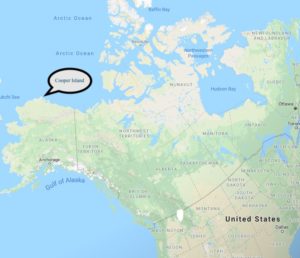
Cooper Island lies 24 miles east of the town of Utqiagvik, formerly called Barrow.
28 Aug
I buried myself in books the last few days. The wind has been fierce, increasing through the day yesterday and last night. It was difficult to measure and weigh chicks today for the strength of the wind. A number tried to escape, half taking flight in the wind and hiding in other sites until I retrieved them. I expect a few will go tonight despite the wind – it didn’t seem that a single adult was in the colony today. I didn’t see any during my checks and not any through the day. The wind hasn’t let up at all.
George is in Barrow. The batteries are all dead, and I’ve had trouble with the radio because of it. There was enough power this morning for about two minutes of radio time. For whatever reason, all four batteries seem to have met their demise. One is continuously hooked to the charger; the others are drained, but that seems odd. In any case, I’ve reconnected them to charge, and if they hold enough from today’s minuscule amount of sun, I may be able to talk with them tomorrow.
George will be, water-dependent, taking a bunch of kids to Crescent Island and Plover Point tomorrow and, in theory, coming out here on Wednesday. Dave can’t boat in this weather; if it holds, I may be here a while. I was a fool to think otherwise.
I’ve been holding myself to five days. In my mind, I still have five days, will continue to have five more days on the island until I actually set foot in Barrow again. It might save me. I’ve done almost nothing but the brief nest checks and read for four or five days. I finished Stones from the River today and dove straight into Love in the Time of Cholera. It is too cold and the wind too fierce for anything else; I am tired and happy to sit. I long for a hot a shower and a sauna. Relief from being cold all the time would be welcome.
I bathed my feet this afternoon and discovered two substantial bruises on my toe – the big broken one. I have no clue how I got bruises on my toe. It bothered me for several days, but it never occurred to me that I bruised it. My feet are tender and were so cold this afternoon that they were painful. My toes are also rotting in the way of feet without warm, dry socks and regular washing. As my feet perspire in my boots, my socks and then the liners get damp, so my feet are perpetually wet and cold. I take the liners out every chance and all night but they never really dry. Alas. Five more days.
I find it hard to believe that there are places in the world, this very minute, that are enjoying warm, lush, green August, its humidity, and sun. I long to be barefoot in the sand or on grass or anywhere my feet can be free and warm…
29 Aug
The infernal, intolerable, eternal wind. As I suspected, the few days of calm last week have been utterly routed and supplanted by wind and the uncertainty of departure. I fantasized about the search and rescue helicopter coming to save me again. Dave said the winds were 30 mph and would increase to 40. The batteries are still not charging, so there was little conversation today. The afternoon was sunny and with no clouds, so perhaps the battery will charge enough for a real bit of talk tomorrow. My return ticket to Fairbanks is for tomorrow morning.
There were hundreds of glaucous gulls today, a few terns and red phalaropes all fighting and feeding in the wind. The wind was nasty, and I hope it dies down tomorrow. In one way, there’s no obligation to do anything but nest checks and then eat and read. On the other hand, being out is so unbearable it’s not worth the reading and eating. I suspect it will be days before a boat can get out here and I’m not likely to be going back on it given George’s desire to debrief.
I’ve almost finished Love in the Time of Cholera, though I only started it yesterday. There’s not much else to do really. The wind seems to have picked up again, and I’ve given in to the fact of its existence. I hold on to my five days.
1 Sept
By radio call on 30 August, the wind had sufficiently died, though it kept me awake most of the night by smacking me in the head with the tent pole. The fog was thick but the air was clearing and George and Dave were talking about a trip out. At 1315 Dave told me the boat was gassed and ready to go. Within 15 minutes, the fog cleared, the sky was blue, the sun strong, and the wind at my back. Wow.
I hauled all the stuff to the sardine box and sat to wait. I was not expecting the water to be so calm and so boatable that quickly after so much wind. It didn’t seem possible that I would be Barrow-bound like that, but there I was all packed up and waiting for the final trip. It was good to see those two – goofy as they are.
I helped George move his stuff to camp and we grabbed and took whatever else he wouldn’t need. I figured the birds were going fast and he wouldn’t need to stay for very long – (as it turned out 15 fledged the next day and another five after that so by today there were only a couple left). Dave and I made a slow trip in, leading another boat that was low on fuel. The wind was behind us, the sun warm and I was happy.
Yesterday was spent in a frenetic race to pack and go. I sent three boxes of books and two boxes with vertebrae. I went off to the recreation center and took a SAUNA. It was great. I scrubbed and scraped and scratched all sorts of layers of grub off me and tried to soak out all the sand and grit and dirt and cold.
This morning, I wandered down to see Dave and say goodbye – it was his birthday. We radioed George, who was in his usual radio form.
Then, into the air. I could see Cooper Island after takeoff – it was clear, the whole outline, south spit and all of the lakes/ponds along the south shore. My last look.




